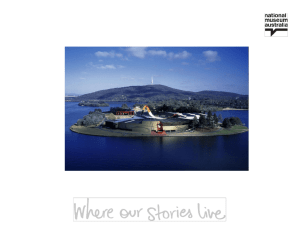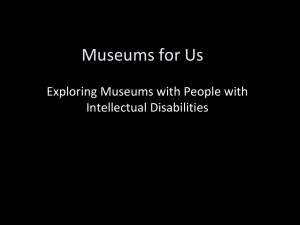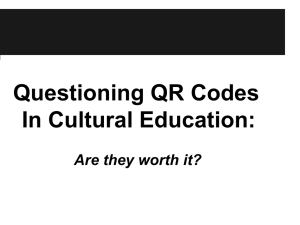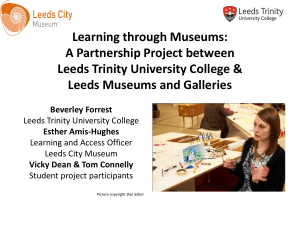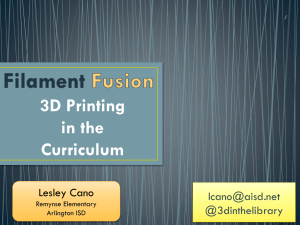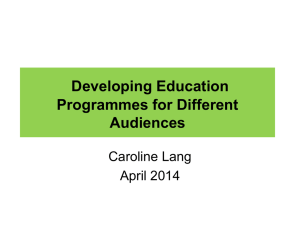Kate McWatters Survey of Art Education Literature 4.25.12 Literature
advertisement
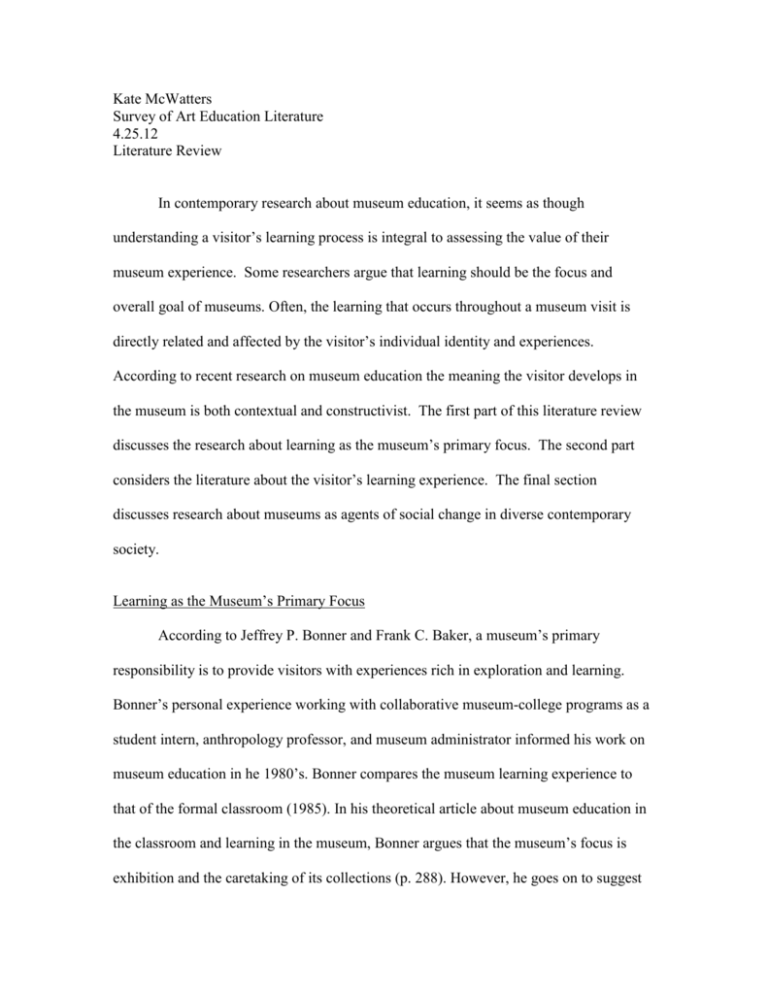
Kate McWatters Survey of Art Education Literature 4.25.12 Literature Review In contemporary research about museum education, it seems as though understanding a visitor’s learning process is integral to assessing the value of their museum experience. Some researchers argue that learning should be the focus and overall goal of museums. Often, the learning that occurs throughout a museum visit is directly related and affected by the visitor’s individual identity and experiences. According to recent research on museum education the meaning the visitor develops in the museum is both contextual and constructivist. The first part of this literature review discusses the research about learning as the museum’s primary focus. The second part considers the literature about the visitor’s learning experience. The final section discusses research about museums as agents of social change in diverse contemporary society. Learning as the Museum’s Primary Focus According to Jeffrey P. Bonner and Frank C. Baker, a museum’s primary responsibility is to provide visitors with experiences rich in exploration and learning. Bonner’s personal experience working with collaborative museum-college programs as a student intern, anthropology professor, and museum administrator informed his work on museum education in he 1980’s. Bonner compares the museum learning experience to that of the formal classroom (1985). In his theoretical article about museum education in the classroom and learning in the museum, Bonner argues that the museum’s focus is exhibition and the caretaking of its collections (p. 288). However, he goes on to suggest that the museum’s focus should shift from the exhibits to visitor learning. He proposes that a stronger relationship be formulated between classroom and museum learning— particularly at the university level. Bonner suggests that a stronger relationship might be formed if classroom educators use museums as teaching resources by integrating museum visits and guest speakers into their curriculums. Additionally museums might occasionally make use of their exhibit space as classroom space to enhance site- specific learning. Bonner also focuses on the importance of providing students with museum internship opportunities for hands-on, practical experience (p. 290). While Bonner suggests that museum education reflect classroom learning, curator Frank C. Baker describes museums as unique educational tools that emphasize visual thought and that could potentially supplements material learned in the classroom (2008). He defines museums as unique learning environments that are the “pioneers in the field of education” where “the majority of the population of our large cities acquire their only knowledge of the great world about them by visits to museums, art galleries, and zoological gardens” (p. 176). Museums provide visitors with site-specific learning experiences that cater to the individual’s inclination to gather large amounts of information visually. Baker states “we acquire much more information through the eye than through any other sense organ of the body” (p. 175). Museums are viewed as institutions capable of providing unique, visually-oriented learning experiences that are meaningful to an individual’s overall education. Additionally, Baker asserts that the “museum is also of value in reinforcing instruction in the universities and other higher institutions of learning” and provides value in the “coordination of all the material which may have been seen in the classroom only as isolated parts of the whole subject” (p.176). Museums act as learning-based institutions in that they are able to provide a real-life context to material discussed in the classroom. Baker’s arguments are based on his experience as a natural history curator at the Chicago Academy of Sciences and the University of Illinois. The Visitor’s Learning Experience Educators and museum theorists Lynn Dierking, John Falk, and George Hein have asserted that visitors’ learning experiences are dependent on their individual contexts and backgrounds. The learning that occurs in museums is constructed by individual response to exhibited material. Dierking and Falk’s first book on museum education, The Museum Experience (1992), strives to define what factors lend to a valuable museum visit. In their second book about museum education, Learning in the Museum (2000) Dierking and Falk explore the key factors that influence learning that should be taken into consideration when designing museum exhibits and programs. Dierking and Falk expand on their “interactive experience model” of learning described in The Museum Experience and delve into what they call, the “contextual mode of learning” (p.10). The contextual mode acts as an extension of the interactive model, the main difference being its definitive focus on the learning process. Based on various visitor case studies, professional experience, and museum theory, Dierking and Falk (2000) explain that learning “is not some abstract experience that can be isolated in a test tube or laboratory but an organic, integrated experience that happens in the real world. The contextual model involves three overlapping contexts: the personal, the sociocultural, and the physical. Learning is the process/product of the interaction between these three contexts” ( p. 10). Dierking and Falk assert that understanding this process is an essential component in creating a truly educational museum experience for visitors. Falk further expanded on his previous work with Dierking in his book Identity and the Museum Visitor Experience (2009). Falk defines a meaningful museum visit as a visit that builds on a direct relationship with the construct of a visitor’s identity. Falk argues that this is preferable to a “complex mix of multiple factors” (p. 9). His updated model postulates “that a museum visit itself is strongly shaped by the expectations an individual develops prior to a visit, based upon his or her own identity-related need, as well as the expectations and views of the larger socio-cultural context” (p. 10). The “visitor experience model” outlines what can and cannot be learned about museums and their visitors. Falk (2009) emphasizes that the museum visitor experience “is an ephemeral and constructed relationship that uniquely occurs each time a visitor interacts with a museum” (p. 158). Also essential to the model is the importance of understanding a visitor’s individual motivation for visiting museums. Falk breaks these motivations into five categories: explorer, facilitator, experience seeker, professional/hobbyist, and recharger. In the segment of the book focused on the practical application of Falk’s model, Falk cites Zahava Doering’s assertion that “rather than communicating new information, the primary impact of visiting a museum exhibition is to confirm, reinforce, and extend the visitor’s existing beliefs” (As cited in Falk, 2009). While Dierking and Falk explore the visitor learning experience from the perspective of the visitor, educator/ theorist George Hein (1998) discusses the museum’s role in promoting visitor learning in his book, Learning in the Museum. Hein includes a history of museum education, educational theory, and visitor studies. Perhaps most significantly is his description of the Constructivist Museum. Hein describes the constructivist museum as one that recognizes meaning to be created by visitors (p. 156). Hein poses three basic questions he deems essential to be addressed for a constructivist agenda include: What is done to acknowledge that knowledge is constructed in the mind of the learner? How is learning itself made active? What is done to engage the visitor? How is the situation designed to make it accessiblephysically, socially, and intellectually- to the visitor (156)? The constructivist museum seems to place visitor learning as one of the most important institutional features. According to Hein, learning should occur in all aspects of the visitor experience, resulting in the creation of meaning. Looking at artwork in the museum Visual literacy Aestetic education Museum literacy Making connections/transfer Cognitive abilities How? Museum Education strategies Vts Postmodern principles Constructivist knowledge Curriculum Museums and their Relation to Contemporary Society Anthropologists and educators Nelson Graburn and Richard Sandell, and the participants in the 1992 Association of Art Museum Directors’ “Different Voices” symposium all argue that museums are both reflectors of contemporary society and potential agents of social change. Similar to Falk, educator and curator Nelson Graburn finds identity and context to be essential in creating a valuable museum learning experience (1977). However, Graburn’s discussion of identity is a more anthropological, societal discussion rather than Falk’s more individual-based theory. Graburn’s article explores the functions of the modern museum through a complete socio-cultural context (1977). He explains that for visitors, the museum experience is based on a combination of prior knowledge and new, original thought. As visitors, “we do not construct meaning from basic axioms in the manner of the scientist but out of selected parts and associations from our total life histories” (p. 2). Additionally Graburn claims that museums should create a free, social environment to allow for a truly enriching experience. This includes “social space, seating areas, and lawns and allow[ing] for heightened and shared social experience” (p. 3). Graburn identifies a major challenge for museums as they attempt “to be all things to all people” (p. 4). Each visitor has a personal motivation for visiting the museum, and it is particularly challenging for museum professionals to address the needs of so many diverse public interests. In a diverse society, museums might strive to create experiences and environments that encourage individual thinking and exploration, whatever that may be to the individual visitor. An edited collection about museums and inequality also explores museums’ role in society, and includes the work of many contributors--- practitioners, academics, and commentators—writing from diverse perspectives. Edited by anthropologist and educator Richard Sandell, this 2002 publication addresses the overlying question of, “What role can museums realistically play in tackling the causes and ameliorating the symptoms of social inequality?” (Sandell, p. xvii). Another prevalent theme Sandell addresses in his introduction to the volume is that “museums are fundamentally social institutions that influence and respond to the changing characteristics and concerns of society” (Sandell, p. xviii). The “Museums and Society: Issues and Perspectives” section, written by Sandell, defines museums to be major potential influences on contemporary society (p. 3). The second section of the book, “Strategies for Inclusion,” contains chapters that describe museums’ approaches to inclusion and their position as active institutions and agents of social change. For example, in the chapter entitled “The National Museums of Kenya and Social Responsibility: Working with Street Children,” written by museum educator Fredrick Karanja Mirara, addresses the museums’ role in society. Mirara describes museums as “cultural institutions [that] have a social responsibility to the communities in which they are located” and that “this requires us to understand community needs and be responsive to social issues” (Mirara, p. 175). Positively interacting with a diverse society is also discussed throughout the 2part “Different Voices” symposium presented by the Association of Art Museum Directors (Different Voices 1992). The program sponsors hoped to “articulate, for the benefit of membership, current ideas and process in art historical scholarship an options for institutional engagement in a clearly more ethnically diverse and culturally challenging age” (p. 5). They asked different scholars to present their work. The proceedings were published by the Association. Each contributor tackles a different outlook on museums and their role in society. One theme that seems to recur is that of communication and audience awareness. Amalia Mesa-Bains, a museum educator, asserts that “differences in time and space, physicality, language, and communication affect the way people enter our institutions, the way they are received in our institutions, and the way in which they learn in our institutions” (p. 97). It seems as though most of the symposium participants agreed that understanding diverse populations is essential to creating a valuable museum experience. After understanding its wide range of visitors, museums must strive to reflect the diverse needs and interests of contemporary society. Multicultural education Visual culture Next Steps To build upon this research in the future, I would potentially like to further research the constructivist museum and its relation to visual thinking strategies. It seems as though the most valuable learning occurs as a result of the individual’s social context, prior knowledge, and motivations. Works Cited Andrei, M., and Genoways, H., Eds. (2008). Museum origins. Walnut Creek, CA: Left Coast Press. Bonner, J. (1985). Museums in the classroom and classrooms in the museum. Vol. 16, No. 4. pp. 288-293. Anthropology & Education Quarterly: American Anthropological Association. Dierking, L. & Falk, J. (2000). Learning from museums: Visitor experiences and the making of meaning. Walnut Creek, CA: AltaMira Press. Different voices: A social, cultural, and historical framework for change in the American art museum (1992). New York, NY: Association of Art Museum Directors. Falk, J. (2009). Identity and the museum visitor experience. Walnut Creek, CA: Left Coast Press, Inc. Graburn, N. (1977). The museum and the visitor experience. pp. 1-5. Walnut Creek, CA: Left Coast Press, Inc. Hein, G. (1998). Learning in the museum. New York, NY: Routledge. Sandell, R. (2002). Museums, society, and inequality. New York, NY: Routledge.


